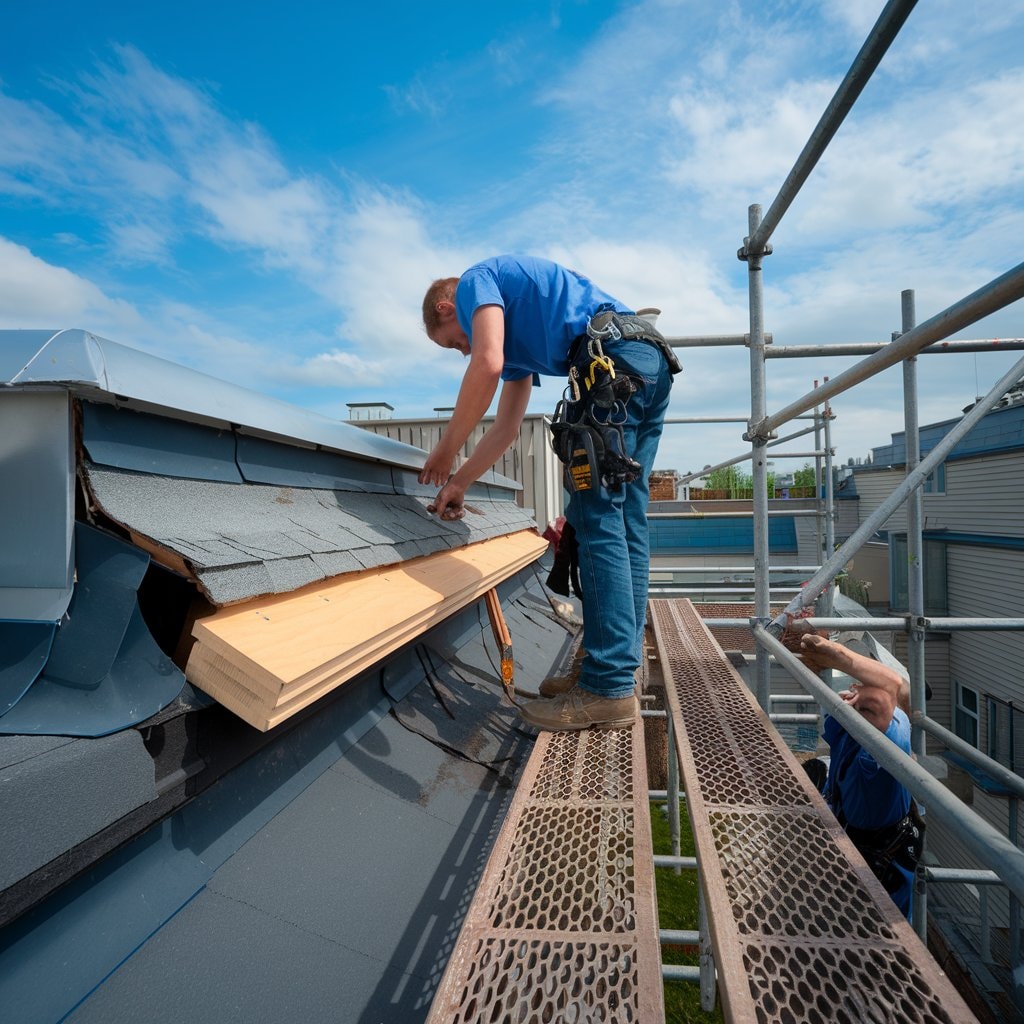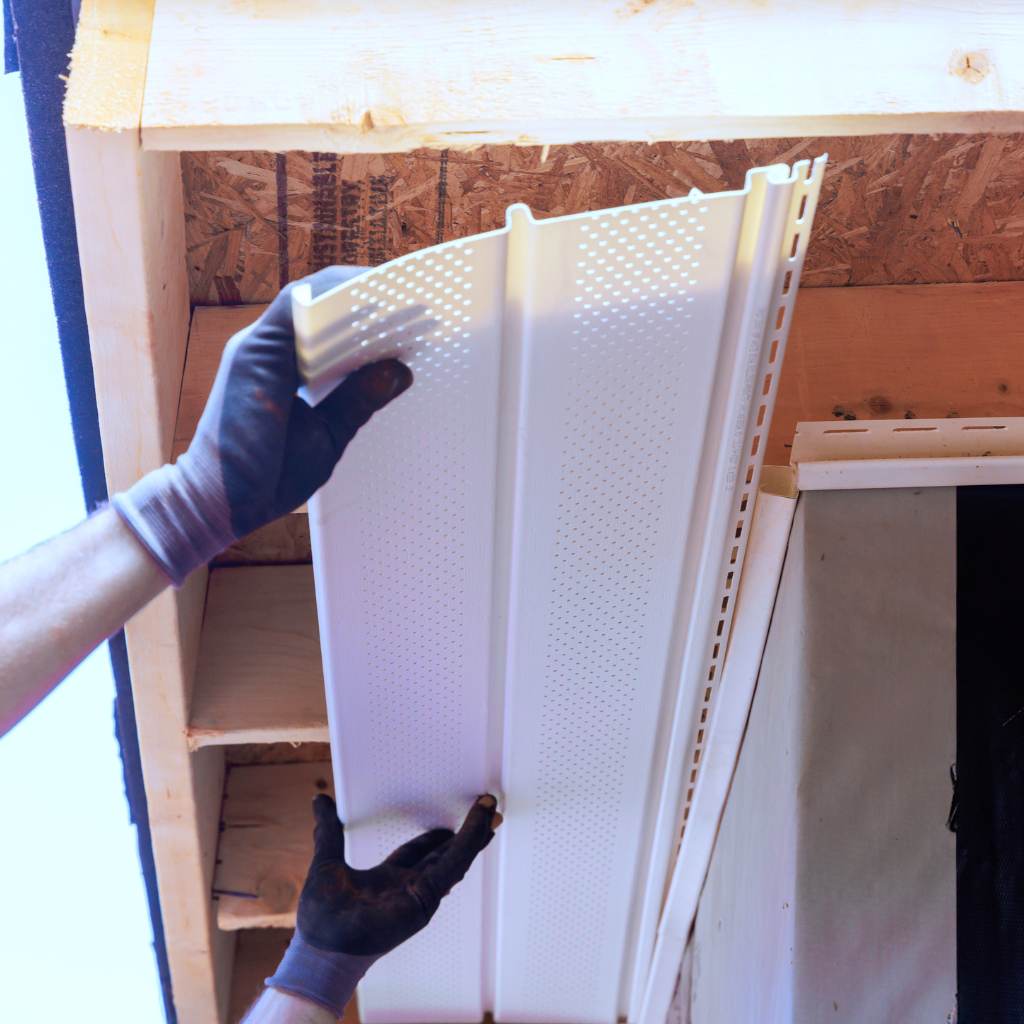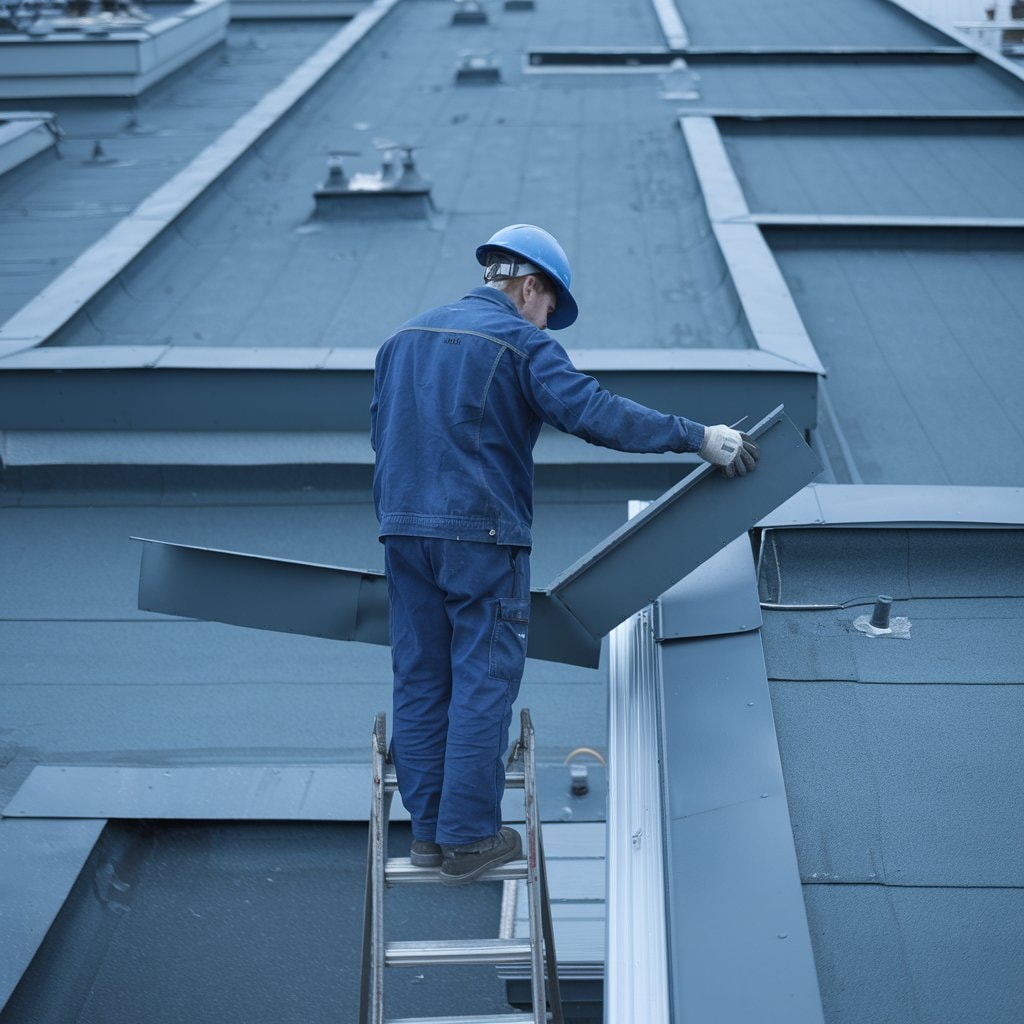Replacing the fascia on a flat roof not only enhances aesthetic appeal but also strengthens the roof’s structural integrity, shielding it from environmental elements. The process, while straightforward, requires meticulous attention to detail, starting with a thorough inspection to assess the extent of damage and decay. Choosing the right materials—be it treated wood or synthetic alternatives—is essential for ensuring long-term durability and resistance to moisture and pests. As we explore the steps involved in removing the old fascia and installing a new one, it’s important to take into account the Consequences of improper installation, which may result in expensive repairs over time. What might these implications be, and how can they affect the overall health of your building?
What is a Flat Roof Fascia, and Why Do You Need to Replace It?
A flat roof fascia plays a crucial role in the roofing system, providing a finished appearance and protecting the roof’s edge from water damage.
It’s important to recognize the signs that indicate a need for fascia replacement, such as rotting or water-stained boards, in order to safeguard the structural integrity of the roof.
Postponing the replacement of damaged fascia can result in more severe issues, including moisture penetration and potential damage to the underlying roof structure.
Understanding the Role of the Fascia Board
The fascia board is an integral component of a flat roof, serving both aesthetic and structural purposes by protecting the roof’s edge and supporting the gutter system. As part of the roof’s assembly, fascia boards play an essential role in maintaining overall roof integrity.
When considering a roof replacement or specifically replacing a flat roof, attention to the fascia is vital. Given its exposure to the elements, the fascia board can deteriorate over time, necessitating a replacement to prevent water damage and maintain the roof’s structural stability.
To fully appreciate the importance of fascia boards, consider the following key points:
- Protection Against Water Damage: Fascia provides a barrier between the edge of the roof and the environment, reducing the risk of water seeping into the roof structure.
- Support for Gutters: By holding up the gutter system, fascia boards help manage water runoff, which is especially critical on a flat roof where water pooling can be a problem.
- Aesthetic Appeal: New fascia board can enhance the appearance of a building, boosting curb appeal and potentially increasing property value.
Understanding the role and value of fascia in roof maintenance is essential when planning for fascia board replacement cost and executing roof repairs or full roof replacement.
Signs That Your Fascia Board Needs Replacement
Recognizing early signs of wear and damage in your flat roof fascia is crucial for timely replacement and avoiding costly repairs. One of the main indicators that your fascia board needs replacement is visible rot. This deterioration occurs when the fascia is exposed to moisture over time, leading to soft, crumbly wood that no longer provides the necessary support or protection.
Similarly, water damage, appearing as discolouration, swelling, or mould growth, indicates that the fascia board needs to be replaced.
Another sign is if the old fascia begins to detach from the roofline. This detachment might be due to loose or corroded nails. To address this, carefully remove the nails and assess the extent of damage underneath. If the damage is extensive, replace the fascia board entirely.
Properly installing fascias involves ensuring they are securely attached and sealed to prevent future water ingress. Fit fascia boards tightly against each other and the roof structure, and ensure they are properly aligned and even.
Proper installation and routine maintenance of these components can greatly extend the life of your roofing system.
Potential Risks of Delaying Fascia Replacement
Delaying the replacement of a deteriorating fascia board on a flat roof can lead to several serious risks, including structural damage and increased repair costs. A timely roof inspection can reveal the need to address issues that, if ignored, can escalate into major concerns.
- Structural Integrity Threats: The fascia board supports not only the lower edge of the roofing material but also contributes to the overall stability of the roof structure. Prolonged exposure to moisture or pest infestation can weaken the fascia, potentially threatening the structural integrity of the entire roof system.
- Water Damage to Adjacent Materials: When fascia boards are compromised, water can seep behind them, damaging the adjacent materials such as roof decking and interior elements. This may result in expensive repairs and the necessity to replace larger sections of the roofing system.
- Non-Compliance with Building Codes: Delaying necessary repairs or replacement can result in non-compliance with local building codes. Professional roofers ensure that the installation of new fascia boards complies with these regulations, thereby preventing legal complications while ensuring the roofing system’s safety and durability.
Engaging a professional roofer to replace or repair deteriorated fascia is imperative. Incorrect installation can further complicate the issues, leading to more extensive damage and repair needs.
How to Replace Fascia Boards on a Flat Roof
Replacing fascia boards on a flat roof demands thorough planning and precise execution. Initially, it is crucial to gather the necessary tools and materials to guarantee the project can proceed without interruptions.
Following that, a detailed step-by-step guide can assist in the removal of old boards and the installation of new ones, while emphasizing the importance of proper ventilation and sealant application to safeguard the structure’s integrity.

Tools and Materials You’ll Need
To successfully replace fascia boards on a flat roof, you will need specific tools and materials tailored for the task. Preparing adequately with the right assortment guarantees that the installation process is smooth and yields long-lasting results.
The primary power tool required is a circular saw, which is essential for making precise cuts on the fascia board to make sure it fits perfectly along the edges of your roof. You will also need to measure the length of the area designated for fascia installation to determine how much material is necessary and where to make cuts.
Safety is paramount; hence, incorporating safety glasses in your toolkit is non-negotiable when working with power tools. This will protect your eyes from potential debris during cutting. Nails are necessary to secure the fascia board firmly in place, ensuring it withstands various weather conditions and remains functional over time.
- Circular Saw: This is for accurate cuts on the fascia boards.
- Safety Glasses: Essential for eye protection while cutting.
- Nails: To securely fasten the fascia board to the roof edges.
Gathering these tools and materials before starting the project will streamline the process and enhance safety and efficiency.
Step-by-Step Guide to Replace Fascia
Prior to starting the replacement of fascia boards on a flat roof, make certain that all necessary tools and materials are readily available and correctly prepared.
The first step involves safely accessing the roof and carefully removing the old gutters. This will expose the fascia board, allowing for a thorough inspection.
Next, carefully remove the old fascia boards. Use a pry bar to loosen and lift them away from the roof edge, taking care not to damage the underlying roof materials.
Once removed, measure the length of the new fascia board needed, ensuring precise cuts for a perfect fit. A circular saw is ideal for making clean, straight cuts.
Before installing the new fascia, double-check the measurements and the condition of the roof where the new fascia will attach. This guarantees a seamless fitting fascia process.
Attach the new fascia board using appropriate fasteners, typically nails or screws, making sure each fastener is securely in place to prevent future issues.
Ensuring Proper Ventilation and Sealant Use
After securing the new fascia boards, it is essential to address roof ventilation and apply a sealant to protect against moisture and promote airflow. Proper ventilation ensures that the attic space remains free from excessive heat and moisture, which can compromise the structural integrity of the roof rafters and trusses.
Applying a high-quality sealant along the fascia board, particularly where it meets the drip edge and flashing, helps prevent water infiltration, which is vital for maintaining the durability of the roof structure.
To optimize both ventilation and sealant use, consider these key actions:
- Ensure Adequate Ventilation: Install soffit vents if not already in place to allow continuous air flow between the roof trusses, which helps regulate temperature and moisture levels in the attic space.
- Apply Sealant Meticulously: Use a waterproof sealant along all seams and junctions between the fascia board, drip edge, and flashing to create a barrier against water penetration.
- Check Gutter System: Ensure that gutters are securely attached and free from blockages, as a well-maintained gutter system helps direct water away from the fascia and roof structure.
These measures will significantly extend the life of the fascia and the overall roof system by preventing common issues caused by poor ventilation and moisture damage.

Should You Replace or Repair Fascia Boards?
When determining whether to replace or repair fascia boards, it is vital to evaluate the extent of damage, such as rot and deterioration. This assessment will inform cost considerations, helping homeowners weigh the expense of replacement against potential repair costs.
Consulting with a professional roofer can provide valuable guidance and guarantee that the decision aligns with both financial constraints and the long-term health of the roof structure.
Assessing the Damage: Rot and Deterioration
Evaluating the extent of rot and deterioration in fascia boards is essential to determine whether replacement or repair is necessary. The fascia plays a vital role as a barrier between the edge of the roof and the outside, protecting the wooden board against water damage and pest intrusion.
If the damage is localized and the wood is still structurally sound, a repair may suffice. However, if the rot has spread across a significant length or the structural integrity is compromised, replacing the entire fascia is advisable.
During the roofing season, roofers need to inspect these boards carefully as they replace flat roof fascia. The right roofing products can extend the lifespan of new fascia boards, ensuring better protection for the house.
- The extent of Damage: Is the rot superficial or deep-seated?
- Age of the Boards: Older boards might be near the end of their service life.
- Potential for Future Problems: Are there signs that the issue could reoccur?
Considering these aspects will guide homeowners and roofers in making informed decisions regarding the upkeep of the wall where the roof meets the house.
Cost Considerations: Fascia Board Replacement Cost
One must consider the costs associated with replacing or repairing fascia boards, as these can differ significantly depending on the severity of damage and the chosen materials.
The cost of replacing fascia boards can be notably higher than simply repairing them, especially if the board behind the visible fascia is still in good condition. Often, if the damage is not extensive, it’s feasible to repair the existing board in place, which reduces labour and material expenses.
Several factors affecting the decision to either replace or repair include the extent of rot or deterioration, the type of materials used, and the potential for future maintenance issues.
Repairing may be relatively easy and cost-effective if the damage is superficial and confined. However, if the underlying board is compromised, you may need to replace the entire section to safeguard the structure’s integrity and that it will last for years.
Choosing to get a new fascia board instead of replacing only the damaged part can be more economical in the long run. This approach might involve a higher initial cost but can save money and time on future repairs, ensuring a longer lifespan for the fascia system under contract.
Consulting a Roofer for Professional Advice
Given the complexities involved in deciding whether to replace or repair fascia boards, seeking professional advice from a qualified roofer can provide valuable insights and guidance.
When faced with such decisions, homeowners might not always know the best way to get the most efficient and effective solutions. A specialized roofer can assess the condition of your fascia and underlying joists to recommend the most appropriate course of action.
Contacting a professional roofer guarantees that all aspects of the project are covered. They can determine if repairing your fascia boards is sufficient or if a complete replacement is necessary for the long-term integrity of your roof. Additionally, a roofer can advise on whether you need to remove the gutters temporarily to access the fascia, which requires careful handling to avoid additional costs.
To further emphasize the importance of consulting with a professional, consider these key points:
- Expert Evaluation: Roofers can inspect the damage from a ladder safely and suggest whether to repair or replace the fascia.
- Cost-Effective Solutions: Advisors provide estimates that balance quality with budget.
- Comprehensive Service: Professionals handle everything from removal to installation, ensuring that each step of the project is efficiently managed.

What Factors Affect the Cost of Replacing Fascia Boards?
The cost of replacing fascia boards on a flat roof can vary widely and be influenced by several key factors.
First and foremost, the choice of materials, such as UPVC versus wood, has a substantial impact on the overall expenses due to differences in price and durability.
Additionally, the size and complexity of the roof structure, as well as the decision between DIY installation and professional hiring, play important roles in determining the final cost.
Material Choices: UPVC vs. Wood
When contemplating the replacement of fascia boards, homeowners often weigh the merits of UPVC against traditional wood, both of which greatly influence the overall cost. UPVC, or unplasticized polyvinyl chloride, is a popular choice due to its durability and resistance to UV rays, which is essential for materials exposed to the elements on flat roofs. Wood, on the other hand, such as cedar, is favoured for its natural appearance and traditional charm. However, wood requires more maintenance over time to prevent decay and damage from environmental factors.
Here are three key points to take into account when choosing between UPVC and wood for fascia boards:
- Durability and Maintenance: UPVC is highly resistant to weather, moisture, and decay, requiring less upkeep compared to wood.
- Aesthetic Appeal: Wood offers a timeless appearance that complements and enhances your home’s architectural style but may need regular painting or staining.
- Cost Effectiveness: Initially, UPVC might be more expensive than some types of wood, like cedar, but its longevity and minimal maintenance requirements can make it more cost-effective in the long run.
Choosing the right material from these options will not only impact the aesthetics but also the long-term costs associated with replacing flat roof fascia and fascia board.
Size and Complexity of the Flat Roof Structure
Understanding the size and complexity of the flat roof structure is key to estimating the cost implications for replacing fascia boards. Larger flat roof areas require more materials for the flat roof fascia, which increases overall costs.
The complexity, such as multiple levels or intricate edge details, also impacts the replacement process. Replacing fascia boards involves removing the old facia, which might be secured with brackets or integrated into the gutter system. This involves careful detachment to avoid damaging the underlying roof surface.
The way to replace fascia boards efficiently is by accurately measuring and cutting the board to fit the specific dimensions of the roof edge. This ensures that the new fascia boards align perfectly behind the fascia, providing top-notch protection and aesthetic appeal.
Additionally, the roof includes multiple gutters or intricate bracket systems. In that case, extra care must be taken to make sure that these elements are properly reattached or replaced during the fascia installation.
Labor Costs: DIY vs. Hiring a Professional
Choosing between DIY and hiring a professional has a substantial impact on the labour costs associated with replacing fascia boards on a flat roof. When contemplating how to replace flat roof fascia, it’s important to review both options carefully. If you have the required skills, a DIY approach can significantly lower costs but may risk issues with installation quality and longevity.
When deciding, take into account the following factors:
- Complexity of Installation: Installing fascia boards at 45-degree angles and making sure they are straight and properly aligned to prevent overflow can be challenging without professional tools and experience.
- Tools and Materials: You should consider acquiring specialized tools. Standard boards are typically 15mm thick, but if your design requires 40mm for better protection, this could influence your choice.
- Time and Effort: Evaluate the time you can dedicate to this project. A professional can accomplish the task more quickly due to their expertise and team size.
Hiring a professional might initially seem more costly, but their expertise ensures that the fascia is installed correctly, which can prevent costly repairs later. Always balance short-term savings against long-term benefits when making your decision.
Conclusion
In summary, the replacement of flat roof fascia and fascia boards is essential for ensuring the structural integrity and longevity of roofing systems. By selecting the appropriate materials, employing precise techniques, and maintaining the installations, homeowners can greatly enhance their roof’s resistance to environmental factors.
Properly executed replacements not only offer better protection but also reduce long-term maintenance costs. It is advisable to consult professionals to achieve the best outcomes in the fascia replacement process.












